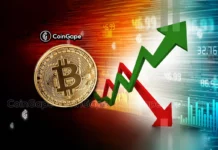Bitcoin broke the $50,000 mark for the first time this weekend. The first cryptocurrency by market cap saw a pullback and now trades at $49,554 with a 2.2% and 5.4% profit in the daily charts, respectively.

The general sentiment in the market has flipped bullish, but many investors still wonder if Bitcoin will be able to sustain its gains or if the recent price action will end up operating as a “bull trap”.
At the time of writing, indicators seemed neutral with analyst first Santiment recording an increase in the total BTC supply on exchanges. This fresh inflow came after the price of Bitcoin rose above $50,000, as trader Ali Martinez noted.

Thus, it seems logical to assumed that some holders have decided to take profits on the recent rally. Thus, the high selling pressure has pushed Bitcoin back to the high $40,000s.
Additional data provided by Ecoinometrics also recorded a rise in the number of addresses accumulating Bitcoin, as the price approach $50,000. As seen below, this suggests that more investors could be interested in buying Bitcoin at its current levels.

Thus, the rally could be more sustainable than in the previous occasions when the price tried to reclaim all-time high levels, only to be rejected back to yearly lows.
In support of the bulls, analyst William Clemente indicated that the Stablecoin Supply Ratio (SSR) has begun to trend upwards. This metric is usually used to measure demand volumes in the crypto market, as many investors rely on stablecoins to purchase Bitcoin and other cryptocurrencies.
Stablecoins starting to flow back into the market. pic.twitter.com/qopR7NbITx
— Will Clemente (@WClementeIII) August 23, 2021
As the chart shows, when the SSR started to descend in January 2021, BTC’s price followed after a period of sideways movement. Although the metric is on the rise, its effects could be felt in the medium term.
Long Term Bitcoin Holders Take Profit, What Could Prevent More Profits
A report published by Glassnode Insights confirmed that long-term holders (LTH) took profits on the rally. However, selling pressure seems low and bulls could continue their push.
Despite the increase in Bitcoin supply held on exchanges, the firm believes that the net flows across these platforms have “stalled”. As seen below, Bitcoin inflows on exchanges increased leading into May and June’s sell-offs but have plateau during July and August.
It is worth noting that the magnitude of inflow is not dissimilar to that seen through the Dec 2020 to April 2021 bull market period and is reasonably expected behavior.
Glassnode claims that, unlike previous cycles, BTC long-term holders are more active and can trade their coins with more frequency. In addition, they believe the selling pressure is being “absorb” by the market.

This suggests “sufficient” demand for these coins now entering a distribution phase. Younger holders seemed to be an important source of demand as the Realized Cap Hold metric “has been swelling throughout August”.
Despite that, the total supply held by long-term investors has reached an all-time high. Thus, Glassnode believes that indicators are suggesting bullish conviction:
The fact this trend has yet to slow down also demonstrates that significantly more coin volume is getting older, than younger. This adds further weight to the argument that the old hand spending observed this week is likely of low coin volume, and strategic de-risking, rather than a loss of conviction and a mass exit.








